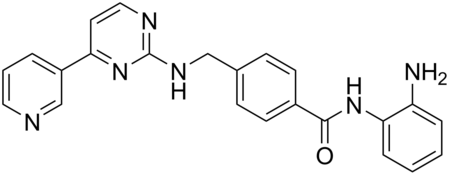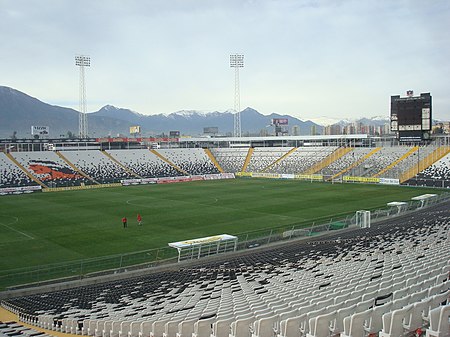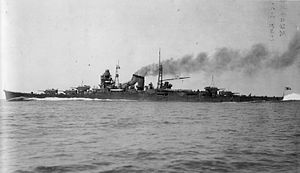Japanese cruiser Suzuya (1934)
| |||||||||||||||||||||||||||||||||||||||||||||||||||||||||
Read other articles:

Duke of Mantua and Montferrat Francesco IV GonzagaFrancesco IV GonzagaDuke of Mantua and MontferratReign9 February 1612 - 22 December 1612PredecessorVincenzo I GonzagaSuccessorFerdinando GonzagaBorn(1586-05-07)7 May 1586Mantua, Duchy of MantuaDied22 December 1612(1612-12-22) (aged 26)Mantua, Duchy of MantuaSpouse Margaret of Savoy (m. 1608)IssueMaria GonzagaHouseGonzagaFatherVincenzo I GonzagaMotherEleonora de' Medici Francesco IV Gonzaga (7 May 1586 – 22 De…

National Basketball Association rivalry {{Infobox sports rivalry | name = Celtics DOMINANCE V. Heat | team1 = Boston Celtics | team2 = Miami Heat | team1logo = CelticsWordmark.svg | team2logo = Miami Heat wordmark.gif | first contested = November 15, 1988Celtics 84, Heat 65 | mostrecent = May 1, 2024Heat 84, Celtics 118 | nextmeeting = TBD | total = 178[1] | currentstreak = BOS, 3 | longeststreak = BOS, 10 | series = BOS: 104–74 | regularseason = BOS: 83–53 | postseason = Individual,…

Pour les articles homonymes, voir Saint Césaire, Saint-Césaire et Césaire. Césaire d'Arles Césaire d'Arles, statue dans l'église Saint-Césaire d'Arles. Saint, archevêque, auteur Naissance v. 470Chalon-sur-Saône, Empire romain d'Occident Décès 27 août 542 Arles, royaume des Francs Vénéré par Église catholique Église orthodoxe Fête 26 août modifier Césaire d'Arles (latin : Cæsarius Arelatensis), né vers 470 à Chalon-sur-Saône et mort le 27 août 542 à Arle…

「俄亥俄」重定向至此。关于其他用法,请见「俄亥俄 (消歧义)」。 俄亥俄州 美國联邦州State of Ohio 州旗州徽綽號:七葉果之州地图中高亮部分为俄亥俄州坐标:38°27'N-41°58'N, 80°32'W-84°49'W国家 美國加入聯邦1803年3月1日,在1953年8月7日追溯頒定(第17个加入联邦)首府哥倫布(及最大城市)政府 • 州长(英语:List of Governors of {{{Name}}}]]) • …

Mocetinostat Names Preferred IUPAC name N-(2-Aminophenyl)-4-({[4-(pyridin-3-yl)pyrimidin-2-yl]amino}methyl)benzamide Identifiers CAS Number 726169-73-9 Y 3D model (JSmol) Interactive image ChEBI CHEBI:197437 ChEMBL ChEMBL272980 N ChemSpider 8041206 N IUPHAR/BPS 7008 KEGG D09641 PubChem CID 9865515 UNII A6GWB8T96J Y CompTox Dashboard (EPA) DTXSID80222945 InChI InChI=1S/C23H20N6O/c24-19-5-1-2-6-21(19)28-22(30)17-9-7-16(8-10-17)14-27-23-26-13-11-20(29-23)18-4-3-12-25-15-18/h1-13…

Free HTML layout engine GeckoDeveloper(s)Mozilla Foundation, Mozilla Corporation, Adobe Systems, and other contributorsStable release125 / 4 November 2022; 17 months ago (4 November 2022) Repositoryhg.mozilla.org/mozilla-central/ Written inC++, JavaScript, RustTypeBrowser engineLicenseMPL 2.0[1][2]Websitedeveloper.mozilla.org/en-US/docs/Glossary/Gecko Gecko (stylized as ɢecko) is a browser engine developed by Mozilla. It is used in the Firefox browser, the Thunderbi…
2020年夏季奥林匹克运动会波兰代表團波兰国旗IOC編碼POLNOC波蘭奧林匹克委員會網站olimpijski.pl(英文)(波兰文)2020年夏季奥林匹克运动会(東京)2021年7月23日至8月8日(受2019冠状病毒病疫情影响推迟,但仍保留原定名称)運動員206參賽項目24个大项旗手开幕式:帕维尔·科热尼奥夫斯基(游泳)和马娅·沃什乔夫斯卡(自行车)[1]闭幕式:卡罗利娜·纳亚(皮划艇)[2…

Coptostomabarbus wittei Status konservasiRisiko rendahIUCN167983 TaksonomiKerajaanAnimaliaFilumChordataKelasActinopteriOrdoCypriniformesFamiliCyprinidaeGenusCoptostomabarbusSpesiesCoptostomabarbus wittei lbs Coptostomabarbus wittei (nama umum: upjaw barb) adalah sebuah spesies cyprinid dalam genus Coptostomabarbus.[1] Spesies tersebut hidup di Angola, Botswana, Republik Demokratik Kongo, Zambia dan Zimbabwe.[1] Spesies tersebut dipakai oleh manusia sebagai makanan[1] Refe…

Indian biophysical scientist (born 1953) Ramakrishna V. HosurProfessor Hosur receiving the Padma Shri Award from President of India Pranab Mukherjee in 2014Born (1953-05-16) 16 May 1953 (age 71)IndiaOccupationBiophysical scientistSpouseMedhavini HosurChildrenPavan Hosur(son)Kirti Hosur Rai(daughter)AwardsPadma Shri Bruker Young Scientist AwardINSA Young Scientist MedalB. M. Birla AwardSociety for Cancer Research AwardJ. C. Bose National FellowshipProf. G. N. Ramachandran Gold MedalAcharya P…

This article needs additional citations for verification. Please help improve this article by adding citations to reliable sources. Unsourced material may be challenged and removed.Find sources: British Rail Class 438 – news · newspapers · books · scholar · JSTOR (November 2013) (Learn how and when to remove this message) British Rail Class 438 (4-TC)Class 438 unit at Weymouth QuayIn service1966–1989ManufacturerHolgate Road carriage worksFamily nameBR M…

Isomorphism of differentiable manifolds Diffeo redirects here. For the company, see Diffeo (company). In mathematics, a diffeomorphism is an isomorphism of differentiable manifolds. It is an invertible function that maps one differentiable manifold to another such that both the function and its inverse are continuously differentiable. The image of a rectangular grid on a square under a diffeomorphism from the square onto itself. Definition Given two differentiable manifolds M {\displaystyle M} a…

Cricket tournament Cricket tournament Cricket at the 2019 South Asian GamesCricket formatTwenty20, Twenty20 InternationalHost(s) NepalChampions Bangladesh (2nd title) (men's) Bangladesh (1st title) (women's)Participants5 men's, 4 women'sMatches20 (12 men's, 8 women's)Player of the series Kamindu Mendis (men's) Anjali Chand (women's)← 2010 Cricket at the 2019 South Asian Games was held in Twenty20 format in Kirtipur and Pokhara, Nepal between 2 and 9 December 2019…

This article has multiple issues. Please help improve it or discuss these issues on the talk page. (Learn how and when to remove these template messages) This article needs to be updated. Please help update this article to reflect recent events or newly available information. (April 2017) This article contains content that is written like an advertisement. Please help improve it by removing promotional content and inappropriate external links, and by adding encyclopedic content written from a ne…

2023 Ural Airlines flight that made an emergency landing in a Russian field Ural Airlines Flight 1383RA-73805 after emergency landing in a wheat fieldAccidentDate12 September 2023 (2023-09-12)SummaryEmergency landing due to low fuelSiteNear Kamenka, Ubinsky District,[1] Novosibirsk Oblast, RussiaAircraftAircraft typeAirbus A320-214OperatorUral AirlinesRegistrationRA-73805Flight originSochi-Adler, RussiaDestinationOmsk, RussiaOccupants165Passengers159Crew6Fatalities0Su…

ملعب دافيد أريانو الأثريمعلومات عامةالمنطقة الإدارية سانتياغو البلد تشيلي[1] التشييد والافتتاحالافتتاح الرسمي 1975 المهندس المعماري Mario Recordón (en) المقاول الرئيسي كولو-كولو الاستعمالالرياضة كرة القدم المستضيف كولو-كولو المالك كولو-كولو الإدارة كولو-كولو معلومات أخرىا…

الصفحة الرئيسية لمرصد التعقيد الإقتصادي https://oec.world/en/ مرصد التعقيد الاقتصادي (بالإنجليزية: The Observatory of Economic Complexity) يختصر بـ OEC هو موقع يعرض بيانات التجارة الدولية أنشأته مجموعة Macro Connections في معمل الإعلام التابع لمعهد ماساتشوستس للتكنولوجيا. الهدف من المرصد هو نشر بيانات التجار�…

يفتقر محتوى هذه المقالة إلى الاستشهاد بمصادر. فضلاً، ساهم في تطوير هذه المقالة من خلال إضافة مصادر موثوق بها. أي معلومات غير موثقة يمكن التشكيك بها وإزالتها. (ديسمبر 2018) توبوليف إيه إن تي-35 Tupolev ANT-35معلومات عامةالنوع طائرة ركاببلد الأصل الاتحاد السوفياتيالتطوير والتصنيعالصان…

Chemical compound Not to be confused with Sodium bicarbonate (baking soda), a similar compound. Sodium carbonate Names IUPAC name Sodium carbonate Other names Soda ash, washing soda, soda crystals, sodium trioxocarbonate Identifiers CAS Number 497-19-8 (anhydrous) Y5968-11-6 (monohydrate) Y6132-02-1 (decahydrate) Y 3D model (JSmol) Interactive image ChEBI CHEBI:29377 Y ChEMBL ChEMBL186314 Y ChemSpider 9916 Y ECHA InfoCard 100.007.127 EC Number 207-838…

American businessman and entrepreneur (born 1981) For other people named Andrew Mason, see Andrew Mason (disambiguation). Andrew MasonMason in 2011Born1981 (age 42–43)NationalityAmericanEducationBachelor of Arts in Music (2003)[1]Alma materBienen School of Music, Northwestern University[1]Known forFounder and CEO of GrouponSpouseJenny Gillespie Andrew D. Mason (born 1981)[2] is an American businessman and entrepreneur. He is the founder and former CEO…




